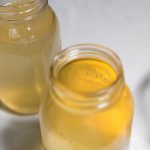How to Make Dashi Broth (Japanese katsuobushi and konbu stock)
There’s nothing like making homemade dashi stock from katsuobushi and konbu. It takes roughly 10 minutes of active prep and 20 minutes of active ‘cooking’. Compare that to the all day cooking of traditional beef and chicken stocks, and you can’t really complain that it ‘takes too long’. Because it doesn’t. Dashi is full of umami and has a wonderful, yet delicate aroma that Japanese cuisine so often embodies. Here’s how I make dashi from scratch. This recipe prepares 1 Liter of Ichiban dashi and 500mL of niban dashi.
- Prep Time: 5 minutes
- Cook Time: 20 minutes
- Total Time: 55 minutes
- Yield: 1.5 liters 1x
- Category: multipurpose
- Cuisine: Japanese
Ingredients
Scale
Ichiban dashi (first dashi)
- 10 grams katsuobushi flakes
- 10 grams konbu
- 1 liter water
Niban dashi (second dashi)
- all of the used katsuobushi (from ichiban dashi extraction)
- all of the used konbu (from ichiban dashi extraction)
- 5 grams katsuobushi flakes (optional)
- 500 ml water
Instructions
Ichiban dashi (first dashi)
- Using a medium sauce pan, soak the konbu for a minimum of 30 minutes.
- After soaking, bring the konbu stock to barely a boil and remove from the pot. Reserve for niban dashi.
- Turn the heat up until the konbu stock begins to boil, add in the katsuobushi flakes and turn heat back down to low.
- Simmer for 3-6 minutes.
- Strain the katsuobushi using a paper towel lined mesh strainer, coffee filter, or nutmilk bag. Do not squeeze the katsuobushi.
- You now have ichiban dashi!
Niban dashi (second dashi)
- Return the katsuobushi back to the pot.
- Add 500mL of water and add back the same konbu used before. Optional: add 5 grams of new katsuobushi, also known as oikatsuo
- Bring the liquid to a just about to boiling, and just as it begins to boil you turn the heat to low and allow to sit at least 5 minutes.
- After that time has passed, strain as before, but this time you can press against the katsuobushi.
- Now you have niban dashi!
- You can reuse the used katsuobushi to make furikake and you can reuse the konbu to make tsukudani, so don’t throw either away!
Notes
If you boil the konbu you risk extracting the bitter compounds from the konbu. It’s important never to boil the ichiban or niban dashi or you risk making the dashi cloudy as well as extracting the bitter/unwanted flavors.
